collapse
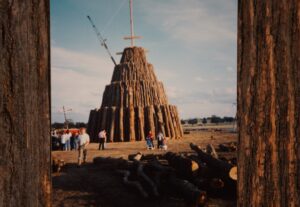
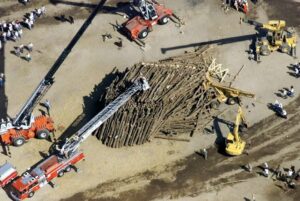 Sometimes, traditions get out of hand, and have to be called off. Such was the case with the Texas A&M University’s annual bonfire. Bonfires have long been associated with high school and college football games, usually for homecoming or the school’s main rival. The bonfire at Texas A&M was a student-built project, that became more and more elaborate every year. The bonfire being built on November 18, 1999, was probably the most elaborate and tallest bonfire structure ever. The 1999 bonfire was supposed to require more than 7,000 logs and was the labor of up to 70 workers at a time. The students had worked all night, and at approximately 2:42am, with a number of students on top of the structure, which at 59 feet high, was actually 4 feet taller than was authorized, the structure collapsed. According to Jenny Callaway, a student survivor working near the top of the stack, “It just snapped.” They had no warning. There was no audible sound, or if there was, it could not be heard over all the chatter. Dozens of students became caught in the huge log pile. Other students, such a Caleb Hill, were relatively unhurt in their 50-foot fall. At the time of the collapse, approximately 5,000 of the planned 7,000 logs were in place. Emergency medical technicians and trained first responders of the Texas A&M Emergency Care Team (TAMECT) rushed to the scene. A student-run volunteer service, who staffed each stage of construction, also began administering first aid to the victims who were thrown clear. TAMECT also alerted the University Police and University EMS, who dispatched all remaining university medics, and requested mutual aid from surrounding agencies. In addition to the mutual aid received from the College Station and Bryan, Texas EMS, Fire, and Police Departments, the members of Texas Task Force 1, the state’s elite emergency response team, were also dispatched to assist the rescue efforts.
Sometimes, traditions get out of hand, and have to be called off. Such was the case with the Texas A&M University’s annual bonfire. Bonfires have long been associated with high school and college football games, usually for homecoming or the school’s main rival. The bonfire at Texas A&M was a student-built project, that became more and more elaborate every year. The bonfire being built on November 18, 1999, was probably the most elaborate and tallest bonfire structure ever. The 1999 bonfire was supposed to require more than 7,000 logs and was the labor of up to 70 workers at a time. The students had worked all night, and at approximately 2:42am, with a number of students on top of the structure, which at 59 feet high, was actually 4 feet taller than was authorized, the structure collapsed. According to Jenny Callaway, a student survivor working near the top of the stack, “It just snapped.” They had no warning. There was no audible sound, or if there was, it could not be heard over all the chatter. Dozens of students became caught in the huge log pile. Other students, such a Caleb Hill, were relatively unhurt in their 50-foot fall. At the time of the collapse, approximately 5,000 of the planned 7,000 logs were in place. Emergency medical technicians and trained first responders of the Texas A&M Emergency Care Team (TAMECT) rushed to the scene. A student-run volunteer service, who staffed each stage of construction, also began administering first aid to the victims who were thrown clear. TAMECT also alerted the University Police and University EMS, who dispatched all remaining university medics, and requested mutual aid from surrounding agencies. In addition to the mutual aid received from the College Station and Bryan, Texas EMS, Fire, and Police Departments, the members of Texas Task Force 1, the state’s elite emergency response team, were also dispatched to assist the rescue efforts.
As with any disaster, word of the collapse spread among students and the community within minutes. By the time the sun rose, the accident was the subject of news reports around the world, and within hours, 50 news satellite trucks were broadcasting from the Texas A&M campus. Because of the precariousness of the structure, the rescue efforts took over 24 hours to complete. The process was slow, because they didn’t want to risk hurting anyone else, or further injuring the students still trapped inside. Students, including the entire Texas A&M football team and many members of the university’s Corps of Cadets, rushed to the site to assist rescue workers with the manual removal of the logs. To further complicate the rescue efforts, they had to call in the Texas A&M civil engineering department to examine the site and help the workers determine the order in which the logs could be safely removed. Also, at the request of the Texas Forest Service, Steely Lumber Company in Huntsville, Texas, sent log-moving equipment and operators to make removal safer for all concerned. At the time of the accident, there were 58 people, students and former students, working on the stack. Of those 58 people, 12 were killed and 27 were injured. Killed in the initial collapse were ten students and one former student. Another student died in the hospital the next day. The last person pulled out alive was John Comstock, who spent months in the hospital following amputation of his left leg and partial paralysis of his right side. He returned to A&M in 2001 to finish his degree.
In the aftermath of the tragedy, “the university gave the National Forestry Hero Award to an employee of Steely Lumber Company, James Gibson, for rescuing students. By 2000 Texas A&M spent over $80,000 so students and administrators could travel to the funerals of the deceased, including $40,000 so 125 students and staff could attend a funeral in Turlock, California by way of private aircraft; most of the persons on board were students. The total amount of funds spent by the university on all disaster-related expenses by that date was $292,000.” For two years, the university tried to decide on a possible way to reinstate the tradition. A task force was formed, and they proposed a new design. The task force recommended that students be allowed to participate in building the bonfire as long as they were monitored by professional construction experts. That plan wasn’t exactly received with open arms by the students. They felt like it would no longer be a student 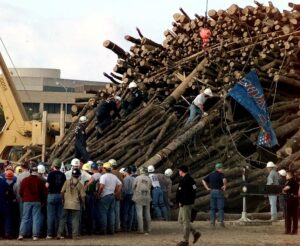
 project. In the end, it didn’t matter, because the cost of a liability policy to cover these events would cost more than $2 million per year. With that in mind, the bonfires were discontinued in 2002. Bowen’s successor Robert Gates upheld this decision. In recent years, some students have held smaller bonfires off campus, but the school is not involved with these. Multiple memorials were held to remember the victims of the disaster.
project. In the end, it didn’t matter, because the cost of a liability policy to cover these events would cost more than $2 million per year. With that in mind, the bonfires were discontinued in 2002. Bowen’s successor Robert Gates upheld this decision. In recent years, some students have held smaller bonfires off campus, but the school is not involved with these. Multiple memorials were held to remember the victims of the disaster.

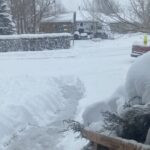 I woke up this morning to about three inches of snow, which has now turned into about twelve to fifteen inches. Spring officially started on March 20th, so my question is…WHY are we looking at so much snow!!! Businesses are closed, schools are on a homeschool day for today and tomorrow, and many of the roads are closed or have “No unnecessary travel” restrictions. I know Spring snowstorms are not that unusual, but I don’t have to like them. Ok, that’s my rant. This isn’t the first Spring snowstorm I’ve ever been through, and most likely won’t be the last. In fact, I remember a few from my childhood, that have been doozies!!
I woke up this morning to about three inches of snow, which has now turned into about twelve to fifteen inches. Spring officially started on March 20th, so my question is…WHY are we looking at so much snow!!! Businesses are closed, schools are on a homeschool day for today and tomorrow, and many of the roads are closed or have “No unnecessary travel” restrictions. I know Spring snowstorms are not that unusual, but I don’t have to like them. Ok, that’s my rant. This isn’t the first Spring snowstorm I’ve ever been through, and most likely won’t be the last. In fact, I remember a few from my childhood, that have been doozies!!
We had a storm in 1973, that totally qualifies as “a doozy” and one I’ll never forget. I had to get up on the roof of my parents’ house and shovel the snow off. The news told everyone that too much snow could cause the roof to collapse. That was the first I had ever heard of such a thing. These days, it’s common knowledge. Of course, 
 schools were closed with that storm too, and people were actually getting around on snowmobiles in town. I remember thinking ho strange that was. Still, there were people who needed to get places, and people with snowmobiles were helping them get there. I didn’t hear of any emergency childbirths with that storm, but I suppose it was possible.
schools were closed with that storm too, and people were actually getting around on snowmobiles in town. I remember thinking ho strange that was. Still, there were people who needed to get places, and people with snowmobiles were helping them get there. I didn’t hear of any emergency childbirths with that storm, but I suppose it was possible.
My niece, Chantel Balcerzak was just a teeny, little girl of two, and the snow was taller than she was. Of course, Chantel is only 4’10” now, so not much has changed, and she might want to stay indoors, so she doesn’t get lost. My dad, her grandpa, Al Spencer took her outside for a picture to commemorate the occasion. Like most snow days, the fre day presented us with a perfect opportunity for fun in the snow, and we took full advantage with snowball fights and trudging through the depths of the “white stuff” that covered the city. It’s funny how that snowstorm seemed so fun, and these days such a storm is just annoying.
I suppose things could be worse. I could be one of those 
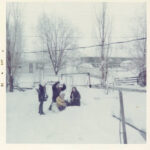 people who will lose wages due to businesses closing, or who have to figure out daycare for children who are now home from school, or who will have to figure out a way to get to work , because my job doesn’t close for snow. Since I am retired, I will just get cozy with a fire going, and watch some television…oh wait, the internet is down which means that my television, email, and internet aren’t working. Thankfully there is wi-fi, so at least there is my phone. That’s my day, I hope you all have a wonderful doozy of a snow day!!
people who will lose wages due to businesses closing, or who have to figure out daycare for children who are now home from school, or who will have to figure out a way to get to work , because my job doesn’t close for snow. Since I am retired, I will just get cozy with a fire going, and watch some television…oh wait, the internet is down which means that my television, email, and internet aren’t working. Thankfully there is wi-fi, so at least there is my phone. That’s my day, I hope you all have a wonderful doozy of a snow day!!
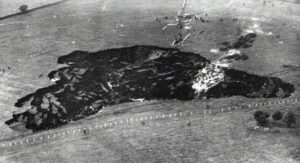 Underground mining always has the potential to become deadly. The people of New Cumnock in Ayrshire, Scotland know that all too well after a mine collapsed, trapped 120 miners underground in Knockshinnoch Castle colliery. The tragic event became known as the Knockshinnoch disaster and it occurred in September 1950 in the village of New Cumnock, Ayrshire, Scotland. The disaster began when a glaciated lake filled with liquid peat and moss flooded the pit workings, trapping more than a hundred miners underground. That set of a rescue effort that lasted for several days. Teams worked non-stop to reach the trapped men. They did finally reach the men, but by the time they were able to reach them, three days later, thirteen men had died.
Underground mining always has the potential to become deadly. The people of New Cumnock in Ayrshire, Scotland know that all too well after a mine collapsed, trapped 120 miners underground in Knockshinnoch Castle colliery. The tragic event became known as the Knockshinnoch disaster and it occurred in September 1950 in the village of New Cumnock, Ayrshire, Scotland. The disaster began when a glaciated lake filled with liquid peat and moss flooded the pit workings, trapping more than a hundred miners underground. That set of a rescue effort that lasted for several days. Teams worked non-stop to reach the trapped men. They did finally reach the men, but by the time they were able to reach them, three days later, thirteen men had died.
The men who survived were all found together 24 hours after the disaster began, and the thirteen men who died had been separated from the main group. They were missing for two more days before they were finally found. When the lake flooded, it released a field about the size of a football field into the mine. The resulting crater was about 300 feet by 200 feet and about 50 feet deep. The crater then sent liquid peat cascading into the mine, effectively blocking any exit for the men.
Thankfully, the mine owners had the forethought to install a phone in the mine, and the miners were able to phone for help. There was no way of reaching them, but the rescuers knew they were still alive, so the rescue efforts began in earnest. Rescue workers decided the easiest way to get them out was through an abandoned mine, next door. It took until 10:30pm local time for the rescuers to clear a passage through the unused mine and break through the final 30-foot wall of coal and rock that separated the two collieries. The rescue team,  made up of hundreds of miners, firefighters, and trained rescuers, worked all day to shore up the walls and ceiling of the old mine. Because the tunnels were so cramped, the workers had to work in shifts, using fans to disperse the gas known as firedamp which accumulates in sealed mines. Firedamp is not poisonous, but it reduces the amount of oxygen in the atmosphere making breathing difficult, not to mention the fact that it is also highly flammable. At one point, a rescue worker collapsed because the air was so foul. He had to be helped to the surface. The situation was really getting serious, and time was running out. The danger of explosion meant the rescuers had to use hand tools to cut through the rock delaying the rescue even more.
made up of hundreds of miners, firefighters, and trained rescuers, worked all day to shore up the walls and ceiling of the old mine. Because the tunnels were so cramped, the workers had to work in shifts, using fans to disperse the gas known as firedamp which accumulates in sealed mines. Firedamp is not poisonous, but it reduces the amount of oxygen in the atmosphere making breathing difficult, not to mention the fact that it is also highly flammable. At one point, a rescue worker collapsed because the air was so foul. He had to be helped to the surface. The situation was really getting serious, and time was running out. The danger of explosion meant the rescuers had to use hand tools to cut through the rock delaying the rescue even more.
Everyone was very focused on saving the trapped men. The volunteers were working above ground, filling the crater made by the landslide with haystacks, trees and other materials to prevent any further slippage. They knew that is more peat fell into the hole, it could have blocked what little ventilation the trapped men had. The buried miners kept in phone contact every 15 minutes or so. They were told how they could help the rescue operation by digging carefully and slowly, so as not to let in a sudden rush of foul air from the unused pit, because they had no oxygen masks to help them breathe.
Finally, the wall was breached. To let the family and friends of the trapped men know that their loved ones were safe, a siren was sounded on the surface. Immediately, huge crowds gathered near the pithead. The police linked arms to form a protective cordon around the exit. The last thing the men needed was a rush of people the minute they reached the surface. Shortly before midnight, rescuers began taking food and drink into the pit for the miners. They had been underground for so long without nutrition and hydration. While the rescuers 
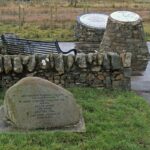 were now with the men, the process of bringing them out of the mine would not be a speedy one. The rescue tunnel was only wide enough for one man to crawl through at a time, and many are said to be weak, so they waited while they ate and drank some water, before beginning the trek out. The Area Manager of the National Coal Board David McArdle has described the rescue operation as the greatest in the history of Scottish mining.
were now with the men, the process of bringing them out of the mine would not be a speedy one. The rescue tunnel was only wide enough for one man to crawl through at a time, and many are said to be weak, so they waited while they ate and drank some water, before beginning the trek out. The Area Manager of the National Coal Board David McArdle has described the rescue operation as the greatest in the history of Scottish mining.
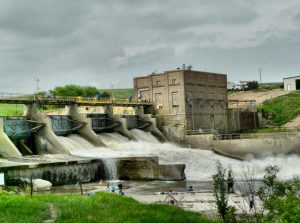
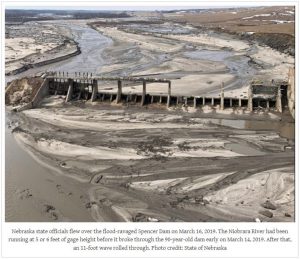 The town of Spencer, Nebraska is a small town of just 423 people, but on March 14, 2019, the town became more well known that it probably ever dreamed it could, or even wanted to be. Suddenly, Spencer, Nebraska was big news, or at least the dam there was. Events unfolded that lead to the collapse of the 93-year-old dam, when the pressure from an icy flood mixed with an area that had a history of unaddressed ice problems. Perhaps it was the rural area of the state, or that they misjudged the surge that could follow a collapse, but they didn’t think that many people would be affected and certainly that no one would die, should the Spencer dam fail. That proved to be untrue, when Kenny Angel, who lived just beneath the dam, was found dead after the flood washed away his home and business. Workers for the Nebraska Public Power District, which operated the dam, warned Angel just minutes ahead of time of the impending danger.
The town of Spencer, Nebraska is a small town of just 423 people, but on March 14, 2019, the town became more well known that it probably ever dreamed it could, or even wanted to be. Suddenly, Spencer, Nebraska was big news, or at least the dam there was. Events unfolded that lead to the collapse of the 93-year-old dam, when the pressure from an icy flood mixed with an area that had a history of unaddressed ice problems. Perhaps it was the rural area of the state, or that they misjudged the surge that could follow a collapse, but they didn’t think that many people would be affected and certainly that no one would die, should the Spencer dam fail. That proved to be untrue, when Kenny Angel, who lived just beneath the dam, was found dead after the flood washed away his home and business. Workers for the Nebraska Public Power District, which operated the dam, warned Angel just minutes ahead of time of the impending danger.
The dam was operated by the Nebraska Public Power District (NPPD). Heavy precipitation during the March 2019 North American blizzard led to a failure of the dam in the early morning hours of March 14th, causing heavy flooding downstream. For a dam that was not expected to do much damage, if it failed, the damage was really devastating…affecting four counties. An 11-foot wall of water was released by the failure, as recorded by a US Geological Survey stream gage moments before it was washed away.
Nebraska regulators had categorized Spencer Dam as a “significant hazard,” which is a rating that meant no loss of life was expected if it failed. With that, no formal emergency action plan was required. After the collapse, it was noted that the Association of State Dam Safety Officials said the dam should have been rated as “high hazard,” which could have led to a plan to modify it to increase its flood capacity. Unfortunately, that was not done, and the failure was terrible. Knox County, the hardest hit of the four counties affected, saw estimates of more than $17M in damages. While the Spencer dam had a history of ice related issues, and other dams may have had ice issues too, the Spencer dam might just be the first dam in the nation to collapse due to 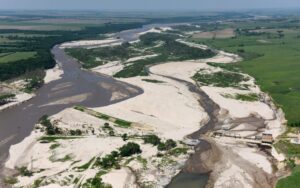
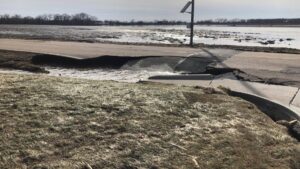 those ice issues. The 11-foot surge of water that followed the collapse took out roads, highways, homes, businesses, and bridges. For several months, motorists were required to detour 150 miles to get past the damage. The flood cut a new channel in the river, meaning a new 1050-foot section of the bridge on Highway 281 below the dam.
those ice issues. The 11-foot surge of water that followed the collapse took out roads, highways, homes, businesses, and bridges. For several months, motorists were required to detour 150 miles to get past the damage. The flood cut a new channel in the river, meaning a new 1050-foot section of the bridge on Highway 281 below the dam.
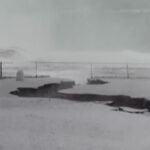
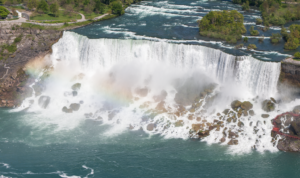 Millions of people visit Niagara Falls each year. It is a beautiful sight, and one you will never forget once you’ve seen it. The boats that take you close to the bottom of the falls guarantee a “rainy” ride. It all seems so safe…right? Well, maybe not always. On July 28, 1954, a huge section of Prospect Point observation area at the brink of the American Falls, collapsed in a pie shaped section. It’s something you would never expect, and yet when you think about it, erosion can happen when you mix water and dirt or rock. Combine that with Winter’s ice, and you get expansion. Now, when you think about it, can you see how the collapse might have happened, because I certainly can?
Millions of people visit Niagara Falls each year. It is a beautiful sight, and one you will never forget once you’ve seen it. The boats that take you close to the bottom of the falls guarantee a “rainy” ride. It all seems so safe…right? Well, maybe not always. On July 28, 1954, a huge section of Prospect Point observation area at the brink of the American Falls, collapsed in a pie shaped section. It’s something you would never expect, and yet when you think about it, erosion can happen when you mix water and dirt or rock. Combine that with Winter’s ice, and you get expansion. Now, when you think about it, can you see how the collapse might have happened, because I certainly can?
The collapse, when it came sent an estimated 185,000 tons of rock thundering into the Niagara River Gorge. Park officials worried that additional sections of Prospect Point would collapse before blasting operations could begin. Following the collapse, engineers and geologists conducted surveys to determine whether blasting would be necessary to stall further rock falls into the gorge. Two sections of Prospect Point were hanging precariously over the 170 foot gorge. Officials estimated that a new fall could send an additional 50,000 tons of rock into the gorge. Engineers appeared to be at a loss as to what to do about the huge pile of rocks now at the bottom of the gorge, as well. A few have said the view from the base of the American Falls has been marred by the mass of rock now laying at the base of the falls. They weren’t even sure if the elevator to the Maid of the Mist landing at the base of the American Falls could be re-opened.
For the sake of safety, Park officials temporarily erected a fence around the collapsed area to keep the curious bystanders away. Thousands of tourists were there that day. They witnessed the huge masses of rock tumbling into the gorge. It was the worst rock fall at Niagara Falls since January 17, 1931 when a huge section of the American Falls tumbled into the gorge. Engineers from the Niagara Frontier State Parks Commission estimate the size of the rock fall as 400 feet long from the lip of the gorge…50 feet wide and 150 feet deep. This included an estimated 20 feet off the Falls crest-line crashed to a point 70 feet down the face.
After the collapse, three giant boulders were silhouetted against the red and blue mist of the Niagara Falls night display. The boulders, some as huge as houses, lay in a jumbled mess beneath the rocks from which they had fallen. Because of the mist, it was hard to see the new scar on Niagara’s face from the lower river. The north face of the American Falls, however, now introduced a raw and torn face to the Canadian side. There would necessarily be some repairs. A face lift would be needed for the new observation area according to Andrew M. Anderson, Executive Secretary and Chief Engineer for the Niagara Frontier State Parks Commission. He also indicated that the new face would be smoothed off by engineers. A new sidewalk and guard rails would be constructed once the area was proven to be safe.
The elevator shaft and tunnel to the Maid of the Mist landing below the Falls although cracked, appeared to be in no danger according to maintenance workers. Cracks in the shaft and tunnel appeared only yesterday 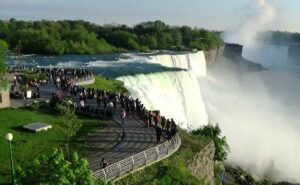
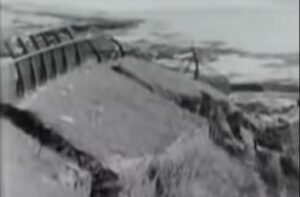 showed no signs of widening when checked last night. Water which had gushed from the crack earlier in the day had dwindled to just a trickle. Geologists examined the building that day and it reopened as soon as it was declared safe. Because so many were able to get pictures and videos of the collapse, some people even thought it was a publicity stunt.
showed no signs of widening when checked last night. Water which had gushed from the crack earlier in the day had dwindled to just a trickle. Geologists examined the building that day and it reopened as soon as it was declared safe. Because so many were able to get pictures and videos of the collapse, some people even thought it was a publicity stunt.
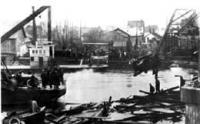 On January 3, 1923, the suspension bridge at Kelso, Washington was nearly finished…but it had not yet been opened, and the old bridge was still in use. The old bridge was just that…old, and they knew it, but until the new bridge was open, the old bridge was all they had. Both bridges spanned the Cowlitz River. Kelso was a small town, with a population of less that 2,000 people on the day in 1923.
On January 3, 1923, the suspension bridge at Kelso, Washington was nearly finished…but it had not yet been opened, and the old bridge was still in use. The old bridge was just that…old, and they knew it, but until the new bridge was open, the old bridge was all they had. Both bridges spanned the Cowlitz River. Kelso was a small town, with a population of less that 2,000 people on the day in 1923.
On that day, the bridge, which was a major roadway in the area was experiencing a traffic jam, due to a stalled car in the middle. To further complicate matters, there was a crowd of people in the area who had gathered to watch a log jam. The combined congestion on the bridge caused the cable that held the bridge up give way. Approximately 100 people were thrown into the flooded and rushing river. The collapse happened at night, making rescue and recovery very difficult. No bodies were 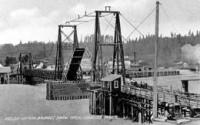 located that first night, and 20 to 30 people were said the be missing. About the same number of people had been rescued from the river with various injuries. To further complicate matters, a transformer in the electric plant had blown out, so there were no electric lights.
located that first night, and 20 to 30 people were said the be missing. About the same number of people had been rescued from the river with various injuries. To further complicate matters, a transformer in the electric plant had blown out, so there were no electric lights.
Two piers of heavy piling provided the foundations for the structure, which was of a bascule suspension type, this construction being necessary because of the fact that the Cowlitz is a navigable waterway. The two lift portions of the bridge meeting at the center were suspended by steel cables from two high wooden towers. With the exception of the steel cables the entire bridge was of wood. The collapsed span of the bridge had been supported by the cables, and when one of the supporting piers buckled under the weight of the traffic, the 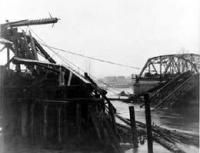 whole bridge went down. Normally the Cowlitz River is a narrow stream, but in times of high water, the river becomes very swift. In this sad instance, heavy rains had flooded the river.
whole bridge went down. Normally the Cowlitz River is a narrow stream, but in times of high water, the river becomes very swift. In this sad instance, heavy rains had flooded the river.
The town of Kelso was in chaos shortly after the crash. People were frantically searching for friends and family. Many rushed to the hospital in search of their people. I they didn’t find them there, they rushed back to the river. Adding to the chaos was the current blackout in the town. At one hospital an operation upon an accident victim was in progress as the lights there flickered. Those who were injured had a long road to recovery, and that was just from their injuries. Still, they were blessed. They lived.

